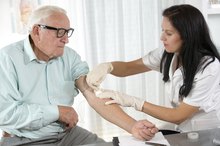High Platelet Levels in the Blood
Platelets are created in your bone marrow and are an important component of blood clot formation. They are stored in the spleen, but eventually, the liver and spleen destroy old platelets. Normally, there are 150 billion to 450 billion platelets per microliter of blood, according to the National Heart, Lung and Blood Institute. High platelet count, or thrombocytosis, may be a symptom of an underlying condition.
Acute Conditions
Reactive, or secondary, thrombocytosis seldom causes symptoms. The increase in platelets may be due to your body's response to healing crisis and inflammation, such as recent surgery. A poorly functioning spleen or having had the spleen surgically removed can account for high platelets in the blood, but complications such as the formation of clots in deep veins -- thrombosis -- are rare, and the liver may be able to compensate. If you experience serious blood loss or iron deficiency anemia it may trigger reactive thrombocytosis. Platelet count may rise in response to bacterial infections of the blood or urinary tract or in conditions such as pneumonia, meningitis and septic arthritis. High platelets can be a feature of Kawasaki disease, an illness that primarily strikes young children of Asian descent.
- Reactive, or secondary, thrombocytosis seldom causes symptoms.
- A poorly functioning spleen or having had the spleen surgically removed can account for high platelets in the blood, but complications such as the formation of clots in deep veins -- thrombosis -- are rare, and the liver may be able to compensate.
MPNs
What Causes a Low Blood Count?
Learn More
Essential, or primary, thrombocytosis may be caused by myeloproliferative diseases, or myeloproliferative neoplasms -- MPNs -- a group of blood cancers affecting the bone marrow. The main types -- polycythemia vera, primary myelofibrosis and essential thrombocytopenia -- may progress to more serious conditions such as myelodysplastic syndrome and acute myeloid leukemia. MPN can strike adults and children. According to the MPN Foundation, these incurable diseases affect approximately 176,000 people in the United States.
- Essential, or primary, thrombocytosis may be caused by myeloproliferative diseases, or myeloproliferative neoplasms -- MPNs -- a group of blood cancers affecting the bone marrow.
Chronic Inflammatory Diseases
Thrombocytosis can be part of the clinical picture of rheumatoid arthritis and inflammatory bowel diseases, such as Crohn's disease and ulcerative colitis. Elevated platelets are one of many abnormal laboratory findings that can be expected in celiac disease, characterized by an inflammatory reaction to dietary gluten that damages the small intestine. Gluten is a protein found in wheat, barley and rye. Strict avoidance of gluten-containing foods can completely resolve symptoms and is the only treatment for celiac disease. A 2002 report in "American Family Physician" reports that gluten intolerance may affect one in 250 persons, predominantly those of European descent.
- Thrombocytosis can be part of the clinical picture of rheumatoid arthritis and inflammatory bowel diseases, such as Crohn's disease and ulcerative colitis.
- Elevated platelets are one of many abnormal laboratory findings that can be expected in celiac disease, characterized by an inflammatory reaction to dietary gluten that damages the small intestine.
Medications
Reasons for Elevated Amylase and Lipase
Learn More
Overuse of medications in the treatment of low platelet count can result in high platelets in the blood. Thrombocytosis also may be an uncommon side effect of antibiotics containing cephalosporin or amoxicillin, such as Cefizox or Augmentin, as well as the combination of piperacillin and tazobactam in Zosyn, used intravenously to treat serious infections.
Related Articles
References
- National Heart, Lung and Blood Institute: What Are Thrombocythemia and Thrombocytosis?
- American Family Physician: Gluten-Sensitive Enteropathy -- Celiac Disease: More Common Than You Think
- MedlinePlus: Platelet Disorders
- Rose SR, Petersen NJ, Gardner TJ, Hamill RJ, Trautner BW. Etiology of thrombocytosis in a general medicine population: analysis of 801 cases with emphasis on infectious causes. J Clin Med Res. 2012;4(6):415-23. doi:10.4021/jocmr1125w
- Brière JB. Essential thrombocythemia. Orphanet J Rare Dis. 2007;2:3. doi:10.1186/1750-1172-2-3
- Morris VK, Spraker HL, Howard SC, Ware RE, Reiss UM. Severe thrombocytopenia with iron deficiency anemia. Pediatr Hematol Oncol. 2010;27(5):413-9. doi:10.3109/08880011003739455
- Oida T, Kano H, Mimatsu K, et al. Thrombocytosis following splenectomy: with or without additional organ resection. Hepatogastroenterology. 2012;59(116):1033-5. doi:10.5754/hge10032
- Yan SL, Russell J, Harris NR, Senchenkova EY, Yildirim A, Granger DN. Platelet abnormalities during colonic inflammation. Inflamm Bowel Dis. 2013;19(6):124. doi:10.1097/MIB.0b013e318281f3df
- Geara A, El-imad B, Baz W, Odaimi M, El-sayegh S. Pseudoleukocytosis secondary to hepatitis C-associated cryoglobulinemia: a case report. J Med Case Rep. 2009;3:91. doi:10.1186/1752-1947-3-91
- Dhaliwal G, Cornett PA, Tierney LM. Hemolytic anemia. Am Fam Physician. 2004;69(11):2599-606.
- Lin RJ, Afshar-kharghan V, Schafer AI. Paraneoplastic thrombocytosis: the secrets of tumor self-promotion. Blood. 2014;124(2):184-7. doi:10.1182/blood-2014-03-562538
Writer Bio
Mary Earhart is a registered nurse, a public health nurse and licensed midwife. Her articles have appeared in professional journals and online ezines. She holds a Bachelor of Science in nursing from California State University at Dominguez Hills. She works in a family practice clinic, has a home birth practice and her specialty is perinatal substance abuse.








